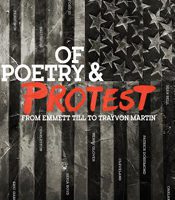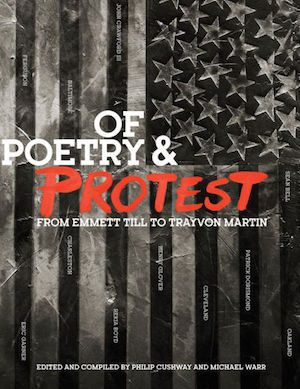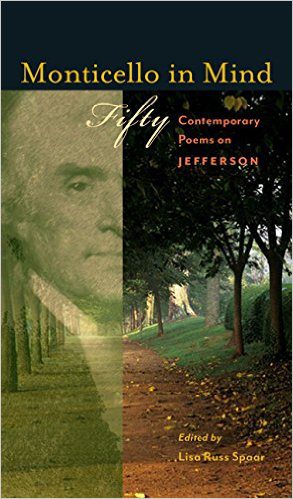America was born with an immoral race problem and will die with it. The late Congresswoman Barbara Jordan got it just right when she said at a Watergate hearing that “When they wrote the Constitution, I was left out.” All writers face this with varying degrees of consent, creativity, and success, often in direct or indirect collaborations with historians and archaeologists.
Of Poetry and Protest: From Emmett Till to Trayvon Martin was edited and compiled by Philip Cushway and Michael Warr, and Monticello In Mind: Contemporary Poems on Jefferson, was edited by Lisa Russ Spaar. Both are eloquent proof of the imperative to wrestle with truth so that it can be transformed, to any degree.
Of Poetry and Protest is coffee-table size, with a stars and stripes in warm, deep gray tones serving as background for the words on the cover. It is perfect packaging , and what is within does not disappoint. “One day this book will be a relic chronicling a period of insanity and inhumanity, I hope,” writes Warr in the introduction. I want to believe he is right, and the poems in its pages, and the interior artwork suggest that he is, even while they illustrate Barbara Jordan’s point.
C.S. Giscombe is one of American poetry’s best landscapers , and “Dayton, OH, ’50s and ’60s” proves it:
all along the road from Cincinnati Gateway City
to the south, had pushed in downtown Germantown hill
in fact as far as the Miami to the east, Wolf Creek
to the north.
Dunbar’s house on Summit overlooked Wolf Creek,
grandly misnamed Riverview Av across the bridge.
When he connects “a big firebombed city w/no name it was really Dayton./ and then says “ I recognized it, ‘’ he’s backtracked seamlessly to World War Two, and the no name is every name. I recognized it too, in my home town, memorialized in a painting that hangs in the Thyssen Bornemisza Museum in Madrid. By John Peto, it is dated 1905, called Toms River, and a rope and a six-pointed star are prominent elements of the composition. Such connections are a necessary exercise between wars and cultures and the locations in which they are rooted, just as the whole book is a necessary example of what poets feel compelled to explore.
In “Conspiracy,” Camille Dungy tells a present-day ghost story that bonds her to her daughter, her mother, her aunt, and their forebears:
to breathe together
Last week, a woman smiled at my daughter and I wondered
if she might have been the sort of girl my mother says spat on my aunt
when they were children in Virginia all those acts and laws ago.
Half the time I can’t tell my experiences apart from the ghosts’.
Part of what makes this beginning so layered is the way Dungy defines the first character. She is a ‘’woman,” and in the next line she is a ‘’girl,’’ an immediate reference to the way black men were called ‘’boy,’’ “all those acts and laws ago.” The “terrible beauty” here is that she is never alone.
Sonia Sanchez takes her music from a self-evident truth in “Elegy (for MOVE) and Philadelphia”:
1.
philadelphia,
a disguised southern city
squatting in the eastern pass of
colleges cathedrals and cowboys.
philadelphia. a phalanx of parsons
and auctioneers
modern gladiators
erasing the delirium of death from their shields
while houses burn out of control.
2.
c’mon girl hurry on down to osage ave
they’re roasting in the fire
smell the dreadlocks and blk/ skins
roasting in the fire.
c’mon newsmen and tvmen
hurryondown to osage ave and
when you have chloroformed the city
and after you have stitched up your words
hurry on downtown for sanctuary
in taverns and corporations
and the blood is not yet dry
The blood will never be completely dry. Sanchez knows this, and so do we, which is another reason this collection is so painfully necessary. And there is still another. In addition to the boilerplate CVs, the editors let the poets speak in prose, and have included essays by Harry Belafonte and others. All are worthwhile, but Sanchez succinctly sums up, in the second half of her prose piece, what they all seek: “ ‘Carlos Fuentes wrote: ‘We only hurt others when we’re incapable of imagining them.’” Everything in Of Poetry and Protest helps us imagine others. And, it goes without saying, ourselves.
Monticello In Mind: Fifty Contemporary Poems on Jefferson is an oddly successful collection. It is no secret that Jefferson is one of the most bizarre, racist enigmas our nation has produced, increasingly defined by the facts that he fathered some of his slaves and wrote gorgeous prose. He also read a lot of poetry. “The reader will discern that nearly all of life is represented here,” Lisa Russ Spaar says in her introduction. That’s a stretch, but should not cloud the reality that most of the poets she invited to contribute have tremendous talent and skill. Yusuf Komunyakaa is one of them, and he also has a fine piece in Of Poetry and Protest. This is his contribution to Monticello In Mind:
“’Daddy Hemmings Was Good With Curves”
Whether a sled, toy, cabinet, desk,
or Jefferson’s landau carriage,
a hundred times he grafted cherry
&mahogany, almost as one, true
to wit & wheels firmly shaped
on a notion, this prime joiner
could square a circle sighting a line
straight down a taut stretch
of twine held by two nails.
Go slow, be patient as the Maker
on the third day, he thought
when facing the puzzle of a job.
Blueprint or not, the plantations knew
he was a man who betted his life
against the seasons in wood.
Did he use the words love & kin
when he asked permission
to marry his beloved Priscilla?
He knew the names & bloodlines
running clear through Monticello
around tree-lined paths & hills
surrounding laconic whispers
of station & contracts. At first,
an out-carpenter, he cut trees,
raised barns, hewed logs & helped
build Mulberry Row where songs
of Ireland & Africa dovetailed
& he learnt the law of every plane,
the slant & set of honed blades,
the curlicues of dust rising
in the morning, the haft
driven by his hands. His sweat
from age fourteen was in wood
held together by pegs & horse glue,
as well as a hundred other cuts
perfectly tongued and grooved
as flesh. He had measured up
a slab of black walnut to save
in the attic for his master’s coffin
before cutting off enough for
a child’s sewing table, working
the saw with & against the grain.
Like the furniture Hemmings crafted, everything that needs be joined just right, does. Like all excellent poetry, it suggests it should be heard, and memorized.
Tess Taylor uses the phrase “Portal to the gone world,” in “Graveyard, Monticello,” and the contradiction says it all, because the world of Jefferson’s legacy is always with us. Natasha Trethewey, who has served two terms as United States Poet Laureate, uses Jefferson’s portrait, and the way it is on display, in “Enlightenment. ” The title is especially resonant because it defines a well known epoch with ideals Jefferson was exposed to and did not measure up to:
In the portrait of Jefferson that hangs
itself, hanging in Monticello, he is rendered two-toned :
his forehead white with illumination –
a lit bulb-the rest of his face in shadow,
darkened as if the artist meant to contrast
his bright subject, its dark subtext.
You suspect where she is going, but that does not detract from how well she tells you :
By 1805, when Jefferson sat for the portrait,
he was already linked to an affair
with his slave. Against a backdrop, blue
and ethereal , a wash of paint that seems
to hold him in relief, Jefferson gazes out
across the centuries, his lips fixed, as if
he’s just uttered some final word.
He hasn’t, and he never will. Trethewey knows this, and makes her way to “see how the past makes us captive,/it’s beautiful ruin etched in the mind’s eye.’’
Monticello itself can never be fully restored, and will always be a “beautiful ruin.’’ All poems in this book help us see that ruin more clearly, make us acknowledge what Charles Wright says in “Christmas East of the Blue Ridge:”
The alphabet of our discontent
Keeps on with its lettering,
gold on the black walls of our hearts.
Monticello In Mind and Of Poetry and Protest letter us in ways that are greater than the sum of their parts. We need them.






